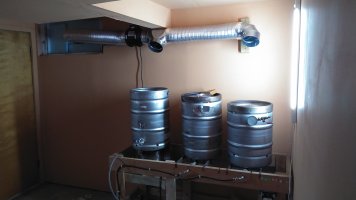I brew in the basement. When we had the house built, I had a spot picked out to serve as my brewing area. The builder ran a gas line and water, but stupid me forgot about a drain. I get by without it but kick myself every brew day.
I installed a Craig's List find of a two bowl commercial sink. It has a drain boards on each end, seven feet long so it takes up most of one wall. Next to it I put in a modified electric 20 gallon water heater. The pressure relief valve is removed, a temp controller added so I can dial in my mash temp. It's mounted up high so I can gravity drain into the mash tun. The brew kettle is natural gas fired. Above it is an exhaust hood vented outside.
On brewery sink I have two faucets. One has adapters for quick disconnect hose fittings for water hookups for things like the plate chiller, pumps and general cleaning.
The brew kettle, mash tun, conical fermenter and a cart have wheels so they can be moved for use or stored away. On one wall I installed peg board for mash paddles, hooks for hardware pieces, gloves, etc.
A few things that are an absolute must in any basement/garage brewery:
Fire extinguisher
Carbon monoxide sensor
Heavy gloves, eye protection
Mop bucket
Just a bunch of food for thought on what you can do. I enjoy brewing in the basement, but it is a walkout basement which helps a lot with cleaning (summer time) and hauling out spent grain. I also serve my beer on the opposite side of the brewing area. Nice to have a refreshing beer after brew day!











